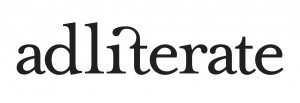‘Tis the season to obsess about trends.
Image courtesy of SonOfJordan.
For those of you frustrated by the lack of sense my trends presentation makes when you only have the charts, here is the story. I wrote it as a column for Brand Republic so its not identical but covers much the same ground.
On the cusp of a new year and in a climate of abject fear about the future, the marketing world is naturally falling over itself to procure the views and services of the trend-spotting world. If only we can make sense of the madness or at the very least look like we know what is going on, perhaps the world will be a better place, or at least seem a little less complicated.
And when they are not being pressed into service to reassure us that everything is going to be fine, trends also offer us all a little light relief, because lets face it the average trends presentation is down right hilarious. This is, after all the natural habitat of the portmanteau, that linguistic flourish invented by Lewis Caroll in ‘Alice through the looking glass’ but so beloved by the trend watching world. Whenever life gets a little hairy you can always chortle to yourself over gems like tribefacturing, engageonomics, materialism and other such abominations so ludicrous that they send your spell checker into spasms as you type them.
So given their pretence to predict, their power to reassure and their ability to entertain it’s no wonder that marketers love a good trend. However, call me old fashioned but I can’t help feeling that while trends are trendy, it is insights that really get stuff done. And it is insights rather than trends that we should all be reaching for as times get tough. Insights like the one that underpinned the AA’s legendary 4th Emergency Service positioning and so profoundly built the business in the mid ‘90s.
Of course as we all secretly know, the problem with really great insights is that, like the White Rhino, they are almost completely extinct in the wild. The sad truth is that for all the research departments that have been rebranded ‘consumer insight’; all the boxes marked ‘insight’ on client brand diagrams; and all the words on agency creative briefs about ‘insight’, real insight is very, very rare. Just because you call it an insight doesn’t make it one.
I can ‘t help feeling that this is a problem of definition. Not the lack of definitions for insight but the fact that there are far too many, most of which wallow around in the nebulous and uninspiring world of consumer or brand truths. What we are in desperate need of is a new action standard for insight. Much like the universities demanded A stared A level grades so they could tell who the really clever kids were, we need a new way to determine whether what we have in our hands is gold dust or guano.
That’s why at Saatchi & Saatchi we use the word revelation in place of insight. This isn’t yet another definition it’s an action standard that demands people raise their game and their expectations when it comes to finding and delivering insight. A revelation does exactly what it says on the tin, it insists that what follows is in some way an astonishing disclosure about people, the brands they engage with or the wider world. No revelation, no insight, it’s as simple as that.
And how to you find revelations? Well I have a few handy tips to help you on your way.
Firstly and simplest of all, ask yourself does it sound and feel like a revelation to you? Is what you have found, been told about or read truly an astonishing disclosure or is it a statement of the bleeding obvious ?
Secondly, real revelations live in the real world not in viewing facilities or behind one-way glass. They show themselves in the day-to-day lives of your customers as much to be observed as reported on. Get out and understand what your customers really care about and what is actually going on in their lives.
Thirdly, in the words of that great marketing commentator, Donald Rumsfeld, look for the unknown unknowns. Revelations will come from the least expected places not simply from finding the answers to questions that you already have – look for the things that you didn’t know, you didn’t know.
And finally the truth is that much that claims to be insight in the world of marketing is actually corporate wishful thinking that over estimates the importance of a brand or product in people’s lives. The route to revelation is through banishing vanity and accepting the honesty and rawness of genuine insight.
Enjoy the conferences, articles and presentations about the killer trends for 2012, but remember two things. Try as I might can’t find a single presentation on trend predictions for 2008 that contained the phrase ‘global economic cataclysm’. And remember that it’s genuine and behaviour changing insights – revelations even – that offer the best protection and opportunity for our brands in the coming year.
Discover more from
Subscribe to get the latest posts sent to your email.


Isn’t the implication of this that, on some occasions, the revelations will elude you (or may not even be there)?
If so, how do you resist the temptation (or demand from client) to water down your definition?
Absolutely right John. When I was putting together examples for the presentation they were very thin on the ground. Creating an action standard doesn’t suddenly open the floodgates of good quality insight. It does give you an aspiration however. I suspect the problem is less clients demanding that you water down the definition – though I know a few that are clinically allergic to proper insight – and more agencies hoping that they will get away with poor quality insight on their briefs precisely because something good has eluded them.
Trend reports in Adland are like bad lunch sandwiches: fillers that leave you wanting something better thought out, planned and executed.
The use, misuse, and obsession about the word ‘insight’ have been an annoyance to me since I started in advertising. I think a part of this problem stems from ‘definition soup’ – the lack of an action standard for insight.
But I feel that’s only half the problem. The other half is what Dodds mentioned: real insight, and revelation, are very, very rare. Any definition will undoubtedly get watered down. As you say: “Just because you call it an insight doesn’t make it one”. I suppose the same applies to ‘revelation’?
Didn’t see your response to John’s comment Richard. If ‘elevation’ can give you an aspiration, that has to be a good thing…irrespective of the watering down problem.
I couldn’t agree more with your point here: ” I suspect the problem is less clients demanding that you water down the definition – though I know a few that are clinically allergic to proper insight – and more agencies hoping that they will get away with poor quality insight on their briefs precisely because something good has eluded them.” – It’s most often an agency (driven) problem.
Happy New Year!
Hi,
My name is Aldo Baker and I’m getting in touch with you regarding your website. I wanted to share the new infographic “Best Infographics of 2011”, and thought this might interest your readers.
You can review the graphic at http://www.sodahead.com/fun/the-life-and-times-of-steve-jobs-is-the-best-infographic-of-2011/question-2374359/
If you like the graphic, I’d appreciate if you could add it to your blog or share it through your social media accounts.
I’m available Monday to Friday 8am-7pm CST, and can be contacted by my direct email me@aldobaker.com
PS. I am more than happy to help you share any future blog post you are trying to get more visibility to.
Thanks,
Aldo Baker
Marketing Director